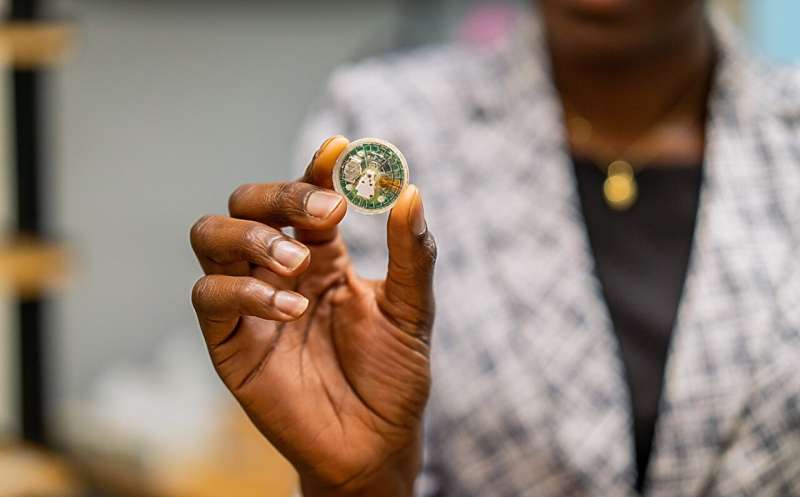This article has been reviewed according to Science X's editorial process and policies. Editors have highlighted the following attributes while ensuring the content's credibility:
fact-checked
peer-reviewed publication
trusted source
proofread
Glucose data reveals seasonal patterns in diabetes care

People with diabetes tend to maintain healthier blood sugar levels in the warmer months from April to September, according to a Dartmouth study published in Science Advances.
The researchers accessed data from wearable glucose monitors that showed how 137 people aged two to 76 living primarily with type 1, aka juvenile, diabetes managed their blood sugar on a daily basis. By analyzing more than 91,000 days of data, the study provides the most detailed look yet at how diabetes management can vary by month, day, age, and even how experienced a patient is with the condition.
"We're looking for specific patterns that could potentially inform clinical guidelines and set the stage for targeted interventions," says Temiloluwa Prioleau, assistant professor of computer science, one of the study co-authors. The authors note that the majority of their study participants had type 1 diabetes, so it is not clear how these findings might generalize to people with type 2 diabetes.
Some researchers and providers have hypothesized that the changes in activity levels, lifestyle, and food intake in different seasons would impact blood-glucose management, says co-author Prajakta Belsare, an assistant professor at James Madison University who worked on the study while she was a postdoctoral fellow in the Department of Computer Science.
In the warm months when activity levels tend to be higher, patients' glucose levels stayed in the healthy range through a larger part of the day than average. In the colder months from October to February, however, the time spent within the normal range was lower than average.
This effect was amplified during the holidays, for participants of all ages, with New Year's Day and Christmas topping the list of days when sugar levels strayed outside the desired target range more often. Despite being a warm weather holiday, Independence Day was third on the list of days when poor glucose control was recorded.
Given the granularity of their data, the researchers also were able to investigate daily and weekly variations. They found that patients' glucose levels were more likely to stay normal from Monday to Friday, and more so in the working hours from 9 a.m. to 5 p.m., than weekends, suggesting that workweek routines have a positive effect.
For Belsare, one of the more interesting results was how effectively different age groups manage their blood sugar.
"We found that young adults in the 19-to-34 age range were less proficient at managing blood glucose," she says. It's likely that this reflects the struggle that newly independent adults face in taking care of their own health without the oversight of parents or caregivers, says Belsare.
The paper doesn't examine the factors driving the patterns they see. "I think the answer for the 'why' would be different for different people," Prioleau says. "Our goal is to highlight what we're observing at a population level. Hopefully, this will encourage people to leverage their own past data to inform and shape their future care, through behavioral changes when feasible, or through other types of intervention."
Andrew Crawford, an assistant professor of medicine at the Geisel School of Medicine and interim section chief of endocrinology at Dartmouth Hitchcock Medical Center who was not involved in the study, says that it could help increase awareness among physicians that certain patients need more focused guidance at specific times of year.
As a physician who treats people with diabetes, Crawford said that the seasonal fluctuations described in the Dartmouth study are indeed consistent with what doctors see. People are less active in colder months and tend to consume more calories and sugary foods around year-end holidays. In warmer months, people are more physically active, which sensitizes the body to the effects of insulin and improves glycemic control, he said.
"What was most surprising to me, however, was that the seasonal variation, particularly the changes around major holidays, were not universal and differed substantially depending on the age of the patient and their general degree of glycemic control during the year," Crawford says. "This underscores the fact that diabetes is largely a self-managed disease and that individuals with less experience managing their disease require additional education and support around major holidays to avoid hyperglycemia."
Given the wealth of insights potentially buried in data from wearable sensors, access to real patient information is vital for research and clinical care, says Prioleau. In a previous study, she worked with Abigail Bartolome, Guarini '23, and collaborators at Geisel to curate an anonymized dataset that the research community can now download to use in future studies intended to demystify diabetes.
"There are a lot of questions around how to personalize (diabetes) management," she says, "and learning from each individual's unique data can set the course towards delivering the best possible outcome for them."
More information: Prajakta Belsare et al, Understanding temporal changes and seasonal variations in glycemic trends using wearable data, Science Advances (2023). DOI: 10.1126/sciadv.adg2132





















